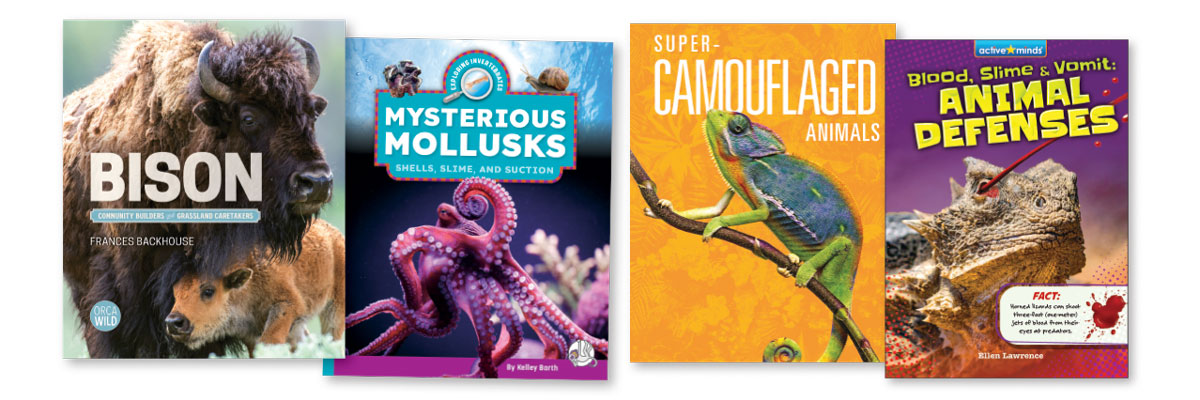Gross and Intriguing | Animals Series Nonfiction
These colorful series cover an exciting and illuminating collection of animal topics, from the adorable to the disgusting.

This spring’s animal series feature a wide range of species and some interesting traits and behaviors. If your collection is low on tardigrade books or you need information on glass frogs or bot fly larva, these books have you covered. If your readers include kids who are fascinated by the grosser side of science, you’ll find animals that vomit, spit, and poop. Several series group animals with similar characteristics, ranging from intelligence and strength to plain old cuteness. With all that variety in mind, it’s still important to look for the qualities that make any animal books for children successful: accurate information, engaging writing, and visual presentations that are both exciting and illuminating. Many of the series below meet those standards.
Elementary
Hall, Alex. Deer. ISBN 9781978541931.
––––. Giraffe. ISBN 9781978541962.
––––. Horse. ISBN 9781978541993.
––––. Rhinoceros. ISBN 9781978542020.
ea vol: 24p. (From Head to Hoof). Enslow. Jan. 2025. Tr. $24.27.
Gr 2-4–These ungulate profiles are neatly organized around the animals’ physical features. Starting with the head and moving downwards to hooves, each area is introduced in a separate spread. Readers learn a few key details about the body part and a bit about how it helps the animal thrive. The size and number of a horse’s teeth is provided, for example, followed by a couple of sentences about their usefulness in eating grass or vegetables. The facts are brief and well-chosen, and work effectively with the visual content. Two photographs on each spread support the focus on features and functions. An eye-catching close-up of a giraffe’s tongue, for example, is paired with a full head view showing the animal using it to eat leaves. In some cases, captions highlight a specific body part or identify a particular species or breed. VERDICT Solid overviews with information that is limited, but accessible to young learners.
James, Ryan. Ants. ISBN 9781684502424.
––––. Butterflies. ISBN 9781684502455.
––––. Cockroaches. ISBN 9781684502578.
––––. Dragonflies. ISBN 9781684502486.
––––. Honeybees. ISBN 9781684502516.
––––. Mosquitoes. ISBN 9781684502547.
ea vol: 24p. (Insects in My Backyard). Rosen/Norwood. Jan. 2025. Tr. $25.27.
Gr 2-4–Common insects are introduced with basic information and clear photographs. Large text provides a couple of facts per page, covering physical features, behaviors, and life cycles. There’s just enough data to convey the most notable characteristics, though details like size and lifespan are not included. Photographs include clear images, mostly full page or half page. Some offer views of various species from around the world. In some cases, close-up photos highlight body parts, such as the abdomen of the honeybee; less useful full-body views are used in other examples, such as the mosquito’s thorax and the butterfly’s abdomen. Each book includes three or four drawings of a child with a magnifying glass which add little to the otherwise strong visual presentation. VERDICT Solid insect profiles to purchase where more coverage is needed.
Lakes, Sabrina. Australian Shepherds at Work. ISBN 9781532455391.
––––. Collies at Work. ISBN 9781532455438.
––––. Corgis at Work. ISBN 9781532455476.
––––. Old English Sheepdogs at Work. ISBN 9781532455353.
ea vol: 28p. (Paws and Pastures: Herding Dogs at Work). Xist. Feb. 2025. Tr. $24.99.
Gr 3-5–These dog profiles introduce the characteristics of herding breeds, along with basic guidance on how to care for them. Each spread covers one topic in three or four sentences. The language is simple and direct, but also generic. The same phrases are used from book to book, and the text is nearly identical for some spreads in all four titles, including sections on herding, training, and games. Some of the guidance is too broad to be practical. “Herding a ball” is recommended in all titles, but with no description of the activity or visual support. Photographs do more than the text to show the differences between the breeds. Many full-page images, along with some spot photos and a full two-page view offer a good mix of the dogs on their own, guiding sheep and cows, and interacting with humans. VERDICT Unexceptional, but adequate for collection holes.
Loh-Hagan, Virginia. Animal Camouflage. ISBN 9781668956465.
––––. Animal Communication. ISBN 9781668956502.
––––. Animal Mysteries. ISBN 9781668956533.
––––. Animal Night Vision. ISBN 9781668956496.
––––. Introduction to Animals. ISBN 9781668956526.
––––. Pack Animals. ISBN 9781668956519.
––––. Spewing Animals. ISBN 9781668956489.
––––. Stinging Animals. ISBN 9781668956472.
ea vol: 24p. (Weird Animal Science: The Breakdown). Cherry Lake/45th Parallel. Jan. 2025. Tr. $30.64.
Gr 2-4–This series combines basic animal facts along with instructions for decoding words and ideas. Opening pages offer reading comprehension tips related to spelling, vocabulary, and critical thinking. Subsequent spreads provide a bit of animal information along with a photo. Four of the eight spreads also highlight those comprehension topics. A half-page “Decode-It” section, for example, breaks down challenging spelling words like “reproduction” into syllables with pronunciation tips. “Build Vocabulary” sections define rare words and the “Make Connections” feature includes a new fact and a question for the reader. The switch from animal information to comprehension exercises doesn’t flow smoothly, and is not helped by the fairly unexciting animal data. Cats and owls are the only named creatures in Animal Night Vision,for example, and half of Spewing Animals relates to humans vomiting. Photos are mostly serviceable but unexciting. VERDICT A mixture of nonfiction and textual decoding with limited child appeal.
Maloney, Brenna. Cutest Animals. ISBN 9781546136118.
––––. Grossest Animals. ISBN 9781546136026.
––––. Scariest Animals. ISBN 9781546136088.
––––. Strangest Animals. ISBN 9781546136057.
ea vol: 32p. (Wild World: Top 10). Scholastic/Children’s Pr. Jan. 2025. Tr. $25.
Gr 3-5–Using a countdown format, each book highlights the unique features of ten animals. Lively writing focuses mainly on the characteristics that earned the creature its top ten status, along with some more general data. The naked mole rat’s physical features land it on the “grossest” animal list, for instance, but readers also learn about its extra-long burrow. Well-designed two-page spreads feature one large, vivid photo, a smaller inset alongside a fact box, and clear, distinct blocks of text. An extra “close-up” spread expands on the information for two of the ten creatures. A highlighted adjective for each animal contributes to the playful tone: the goblin shark is “Savage!” for example, while the axolotl is “Adorable!” No criteria are offered for the rankings, but the countdown serves as a fun way to introduce some especially interesting and unusual animals. VERDICT High appeal for browsers.
Murray, Julie. Fossa. ISBN 9798384903048.
––––. Glass Frog. ISBN 9798384903055.
––––. Saiga Antelope. ISBN 9798384903062.
––––. Secretary Bird. ISBN 9798384903079.
––––. Sun Bear. ISBN 9798384903086.
––––. Uakari. ISBN 9798384903093.
ea vol: 24p. (Unusual Animals). ABDO/Abdo Kids Jumbo. Jan. 2025. Tr. $34.22.
Gr 1-3–Each book introduces the basic facts about an animal that most young learners won’t know much about. With a few sentences per spread, the text describes standard attributes, like size, habitat, and diet, while also noting unique features such as the glass frog’s transparent skin and the featherless lower legs of the secretary bird. Each spread includes one large photograph, usually showing the animal in the wild. Many images highlight physical traits, like the sun bear’s tongue, or activities described in the text, such as the fossa’s climbing ability. A range map and a brief “more facts” page round out these simple but appealing presentations. VERDICT Interesting and accessible profiles for younger readers that may also fill subject holes in animal collections.
O’Daly, Anne. Builders. ISBN 9781835720233.
––––. Helping Out. ISBN 9781835720240.
––––. Hiding Away. ISBN 9781835720257.
––––. Keeping in Touch. ISBN 9781835720264.
––––. Super Senses. ISBN 9781835720271.
––––. Using Tools. ISBN 9781835720288.
ea vol: 24p. (Animal Smarts). Brown Bear. Jan. 2025. Tr. $35.70.
Gr 2-4–Each title introduces eight especially intelligent animals. A two-page spread for each includes a large photograph and spot image, a brief “fact file” with general information, and interesting details about their highlighted features. Super Senses, for example, covers eagles’ eyesight, bears’ sense of smell, and the electrical sensors of the hammerhead shark, among others. Clear, simple text is well-supported by the illustrations. In Builders, readers learn why weaverbirds build nests, how they go about it, and what those nests looks like. A clear photo shows the bird at work, with captions and arrows to clarify the process. Insets are equally effective: the large close-up photo of a firefly is complemented by a spot photo showing many of the insects lighting up a forest. The set includes a good mixture of common animals and more unusual species such as decorator crabs and bowerbirds. VERDICT Well-conceived profiles of interesting animals.
Wood, John. Poo at the Zoo. ISBN 9798892327527.
––––. Poo Down Under. ISBN 9798892327510.
––––. Poo in the City. ISBN 9798892327497.
––––. Poo in the Desert. ISBN 9798892327503.
ea vol: 24p. (Whose Poo? Set Two). Bearport/Fusion. Jan. 2025. Tr. $30.95.
Gr 2-4–A visual guessing game helps introduce facts about animal excrement. Each book highlights four examples of animal poo. A two-page spread offers a large photo of the animal’s deposits along with captions pointing out qualities, like the grass and seeds shown in the rhinoceros example. Readers are asked to identify the creature, choosing from three inset photos. A page turn reveals the answer, along with images of the animal responsible for the poo, and a bit more information about how it gets produced. Word balloons for the animals add some humor, and the overall tone is lighthearted. At the same time, the scientific data is relevant, as readers learn how feces’ shapes, sizes, and texture relate to the animals’ lives. VERDICT A fun choice for kids who enjoy exploring the grosser side of animal science.

Upper Elementary to Middle School
Backhouse, Frances. Bison: Community Builders and Grassland Caretakers. 96p. Apr. 2025. ISBN 9781459839236.
Gudgeon, Christopher. Great Apes: Protecting Our Animal Cousins. 88p. Feb. 2025. ISBN 9781459838109.
Leiren-Young,Mark. Octopus Ocean: Geniuses of the Deep. 104p. Feb. 2025. ISBN 9781459838956.
ea vol: (Orca Wild). Orca. Tr. $24.95.
Gr 5-8–Each of these engaging and informative books opens with the author describing a personal interaction with the featured animal. Subsequent chapters provide thorough and accessible profiles, covering physical features, behaviors, evolution, history, and endangered status. The writing style is conversational at times, but also filled with fascinating scientific information. The authors’ enthusiasm for their subjects comes through clearly. Biological data is balanced neatly with personal stories of scientists and short portraits of individual animals like Sid, the octopus escape artist, and Koko the gorilla. Current scientific discoveries as recent as 2024 are noted. Visual content includes many well-chosen photographs, along with drawings and useful diagrams. Closing chapters highlight current threats to the creatures, along with suggested ways that people can help. VERDICT First-rate animal nonfiction for middle school readers.
Barth, Kelley. Mysterious Mollusks: Shells, Slime, and Suction. ISBN 9781503894501.
––––. Nematodes and Tardigrades: Small but Mighty. ISBN 9781503894549.
––––. Stinging Cnidarians: Jellyfish and Their Kin. ISBN 9781503894532.
Ipcizade, Catherine. Amazing Arachnids: Spiders and Their Relatives. ISBN 9781503894488.
––––. Awesome Annelids: The World of Worms. ISBN 9781503894518.
––––. Important Echinoderms: Spineless Superheroes. ISBN 9781503894525.
––––. Investigating Insects: All the Buggy Facts. ISBN 9781503894471.
Scheffer, Janie. Cool Crustaceans: Invertebrates of the Sea. ISBN 9781503894495.
ea vol: 24p. (Exploring Invertebrates). The Child’s World/Wonder Jan. 2025. Tr. $32.79.
Gr 4-7–This useful series introduces the major groupings of invertebrates, with information about the class or phylum as well as some facts about individual species. The first couple of chapters look at the common features and unique behaviors within the group. Multiple examples of species are briefly introduced, often with especially interesting characteristics highlighted, such as sea stars’ regeneration ability. Photographs offer good close-up views of the animals, from microscopic images of tardigrades to the bizarre body of an arrow crab, though many species are named and briefly described without an accompanying photo. A life cycle chapter includes a clear diagram. The last two chapters note each group’s role in the earth’s ecosystem and its prospects for survival in the future. VERDICT Accessible, appealing overviews, some of which introduce species that will be new to many young learners.
Greve, Meg. Super-Camouflaged Animals. ISBN 9781645823766.
––––. Super-Dangerous Animals. ISBN 9781645823773.
––––. Super-Fast Animals. ISBN 9781645823780.
––––. Super-Incredible Dinosaurs. ISBN 9781645823803.
Mattern, Joanne. Super-Deadly Animals. ISBN 9781645823810.
––––. Super-Gigantic Animals. ISBN 9781645823797.
––––. Super-Smart Animals. ISBN 9781645823827.
––––. Super-Strong Animals. ISBN 9781645823834.
ea vol: 24p. (Super-Incredible Animals). Black Rabbit/Top Rank. Jan. 2025. Tr. $35.70.
Gr 4-7–Each book offers brief profiles of six animals with particularly impressive features or abilities. The text typically identifies the creature’s “super” quality, then offers one or two examples of how the ability is used in the wild. In some instances, key information is not provided; we learn how heavy the green anaconda is, for example, but not its length, and several dinosaurs are introduced with no size data. Animal choices are well-varied and sometimes surprising. Super-Fast Animals , for instance, includes the cheetah and the peregrine falcon, but also the speedy mite. Photographs include full-page images of the animals, often demonstrating their featured abilities. Selected images are vertically oriented and offer impressive two-page views once the book is rotated. An attractive “More to Explore” section closes each book, providing a range map, fun facts, and visual comparisons. VERDICT Mostly interesting facts and strong visuals offer solid browsing appeal.
Lawrence, Ellen. Blood, Slime, and Vomit. ISBN 9798765409947.
––––. Dangerously Deadly Monster Fish. ISBN 9798765409978.
––––. Poop, Spit, and Poison. ISBN 9798765409954.
––––. Prehistoric Predator: Megalodon. ISBN 9798765409961.
ea vol: 34p. (Active Minds: Awful Animal Facts). Phoenix/Sequoia. Jan. 2025. Tr. $22.99.
Gr 4-6–The gross and violent side of animal life takes center stage in this series. Prehistoric Predator: Megalodon goes in-depth on a single species, while the other three titles each highlight five or six different examples with common behaviors. The writing tone embraces the “awful” theme of the series, highlighting features like slime, blood, and excrement. Cartoon word balloons with interjections like “Wow!” and “Oooh” add to the lighthearted tone. There’s also plenty of straightforward scientific data presented in two or three text boxes per spread. Most photographs depict the animals in the wild, sometimes interacting with humans. Close-up images, like one showing the mouthparts of a bot fly larva, are well-chosen and useful. Occasional maps and diagrams round out the generally engaging visual presentation. VERDICT Especially appealing to kids drawn to the disgusting (but interesting) elements of animal life.
While most of these series are aimed at elementary school aged readers, “Orca Wild” (Orca) stands out as an especially readable and informative series for older learners, providing in-depth information and highly engaging writing. For slightly younger kids, “Wild World: Top 10” (Scholastic/Children’s Press) and “Animal Smarts” (Brown Bear) do an excellent job of introducing intriguing animals by focusing on their unique features through lively writing and strong visuals. “Unusual Animals” (Abdo Kids) is a top choice for younger kids, introducing less commonly known species with a presentation that’s just right for the intended age level. For shock value backed by solid science, “Awful Animal Facts” (Phoenix/Sequoia) and “Whose Poo?” (Bearport/Fusion) offer strong browsing appeal.

SPRING 2025 SERIES MADE SIMPLE REVIEWS
RELATED
The job outlook in 2030: Librarians will be in demand
The job outlook in 2030: Librarians will be in demand
ALREADY A SUBSCRIBER? LOG IN
We are currently offering this content for free. Sign up now to activate your personal profile, where you can save articles for future viewing






Add Comment :-
Be the first reader to comment.
Comment Policy:
Comment should not be empty !!!